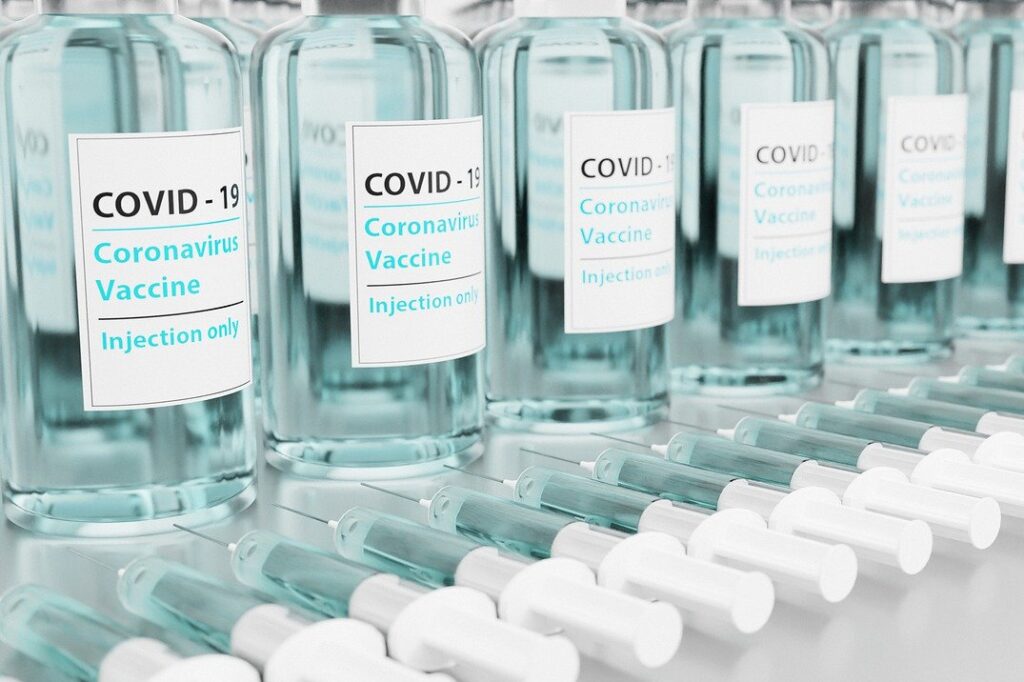COVID-19 has negatively impacted routine immunization rates across the world as medical providers, patients, and parents have faced challenges wrought by the pandemic. According to data published by the World Health Organization (WHO) and UNICEF, 23 million children worldwide missed out on routine childhood immunizations in 2020, an estimated 17 million of whom likely went completely unvaccinated. In the United States, new data indicate that nearly 27 percent of surveyed households had at least one or more children who missed or delayed a preventive visit because of the pandemic. New strategies are needed to identify and catch-up children who have missed routine immunizations to prevent future outbreaks of vaccine-preventable diseases.
This paper outlines strategies states may consider to improve routine childhood vaccination rates and catch-up the millions of children who are behind on vaccinations due to the challenges posed by the pandemic.
Background
Immunizations are a key component of primary health care and missed opportunities to provide immunizations negatively impact health, learning, and productivity. In the U.S., routine immunizations prevent 16 infectious diseases in children, including measles, influenza, hepatitis A, tetanus, pertussis (whooping cough), and varicella (chicken pox) and prevent several more diseases in adults, including pneumococcal disease and herpes zoster (shingles). Vaccines against hepatitis B and human papillomavirus (HPV) also prevent several types of cancer. Even prior to the pandemic, race and ethnicity, poverty, and lack of insurance caused inequity in vaccination coverage rates, but the pandemic has widened these gaps. Routine medical visits decreased sharply during the pandemic due to reduced access to providers and parental concerns about infection, while unprecedented numbers of sick patients and backlogs on preventative visits stressed health care providers. Public health clinics, once the mainstay of equitable vaccine administration, have had to prioritize COVID-19 testing, contact tracing, and vaccination over preventive care. Schools, which typically serve as gatekeepers ensuring students are fully vaccinated prior to attending school, have had to reallocate resources to remote learning, staff shortages, and their own contact tracing. The result has been a perfect storm that has resulted in declining routine vaccination rates, leaving millions of children vulnerable to vaccine-preventable diseases.
Communicating the importance of routine vaccinations
Providers are at the front lines of identifying the need for immunizations, making strong recommendations to parents to vaccinate their children, and documenting what was administered in the state or local immunization information system (IIS). States, however, can play a critical role in communicating with the public about the importance of routine immunizations and developing new strategies to re-gain the public’s trust.
- Several states, including Virginia, Tennessee, New Jersey, Nevada, Maryland, and Kansas, issued Governor’s proclamations recognizing August as National Immunization Awareness Month to raise awareness of the importance of immunizations and encourage families to make routine vaccination a priority.The health observances calendar provides many additional opportunities where this strategy might be used to draw attention to the need to catch children up on routine vaccinations outside of the back-to-school season, including during National Minority Health Month (April), National Public Health Week (April 1-7), World Immunization Week (April 22-28), Every Kid Healthy Week (April 25-29), National Infant Immunization Week(April 25-May2), Hepatitis Awareness Month (May), and others.
- Minnesota publishes a webpage dedicated to Pediatric Immunization Gaps Due to the COVID-19 Pandemic, which offers county-level data on vaccination coverage rates as well as considerations for health care providers.
- Several states created innovative influenza vaccination campaigns for the 2021-2022 season that could be adapted to encourage parents to catch their children up on routine childhood immunizations:
- Rhode Island, ranked first in the U.S. for influenza vaccination coverage, involved Governor Dan McKee in the state’s vaccination campaign. The Governor encouraged Rhode Islanders to get both their flu and COVID-19 vaccines stating, “Both shots are important to building a healthy, resilient Rhode Island.”
- South Dakota boasts one of the highest vaccination coverage rates in the country with 55.4 percent of residents vaccinated as of February 27, 2022. Their campaign draws attention to the personal cost of influenza illness: “two weeks of sick leave, zero sleep, and 175 boxes of tissue, or one flu shot? You do the math.”
- This fall, Delaware hosted flu clinics for children between the ages of 6 months and 18 years old. They also hosted flu clinics for anyone aged 9 or older who were without a healthcare provider or without insurance coverage for the vaccine.
- Each year, Tennessee holds a one-day “Fight Flu TN” event, standing up free vaccination clinics in over 100 locations across all 95 counties and vaccinating nearly 10,000 individuals on one day. Sites are walk-through or drive-through and participants do not need an appointment to get vaccinated.
Using pharmacists as vaccinators
While the national Declaration of Emergency is still in place, states have opportunities to expand access to immunizations for children by using pharmacists as vaccinators. Under the Public Readiness and Emergency Preparedness Act (PREP Act), pharmacists are authorized to order and administer childhood vaccines to children ages 3-18 years. Pharmacy interns are also authorized to administer vaccines. Pharmacists have long participated in administering seasonal influenza vaccinations to adolescents and adults and have provided tremendous support to COVID-19 vaccination efforts. This expansion of authority through the PREP Act allows pharmacists who have previously been prohibited from vaccinating children under state law to provide those services until October 1, 2024, or the final day the Declaration of Emergency is in effect, whichever occurs first. Additionally, separate from the PREP Act, some states have utilized emergency authorizations or have passed legislation to authorize pharmacists and other professionals to administer COVID-19 and other vaccines.
- Public health jurisdictions, such as New York state, New York City, and Utah, have had success in enrolling independent pharmacists in the Vaccines for Children Program (VFC). Participation in VFC expands vaccine access for children who are uninsured or insured by Medicaid, especially those living in rural areas where access to pediatric health care may be limited.
- In Texas, a task force on pharmacist engagement developed three tools for use by pharmacists to satisfy the requirements set out by the PREP Act authorizing pharmacists to administer childhood vaccines. The PREP Act requires that the licensed pharmacist inform the parent of a child receiving a vaccine of the importance of a well-child visit with a pediatrician or other licensed primary care provider and refer the patient, as appropriate. The task force provides a well child visit brochure, as well as customizable templates for a well child visit referral form and well child check-up letter that pharmacists may use to comply with PREP Act requirements.
Using digital tools
Digital tools, such as immunization information systems (IIS), allow states to establish standards for reliable documentation of administered vaccines. Furthermore, providing consumers with access to their immunization records and the forecasting schedules stored in their state or jurisdiction’s IIS helps to empower informed decision-making. Providing this access also reduces burdens associated with obtaining records from healthcare providers and health departments. In a survey conducted during a consumer access pilot project, 35 percent of those who accessed their records indicated they had an overdue vaccination, and 36 percent of those individuals took action by calling or visiting their healthcare provider. While access predated the pandemic in several states, the need for individuals to verify their COVID-19 vaccination status has propelled these efforts forward. Several jurisdictions (Maryland, District of Columbia, Washington, Illinois, Wisconsin, and others) now allow individuals to access their immunization records through the jurisdiction’s IIS.
Enforcing of school vaccination requirements
States play a critical role in ensuring children are fully vaccinated prior to school entry. All states and U.S. territories have school vaccination requirements, although the process for implementing these requirements varies. These requirements are important tools in keeping vaccination coverage rates among students high and disease burden low, but the administrative and logistical challenges of the pandemic have made enforcement of these long-standing requirements difficult. Many schools began the 2020-2021 academic year with remote learning, disrupting the annual process of confirming vaccination status prior to students attending school.
While all 50 states and Washington, D.C. accept medical exemptions for required vaccinations, 44 states and Washington, D.C. also accept religious objections to vaccinations and fifteen states allow philosophical objections. California, Mississippi, West Virginia, New York, Maine, and Connecticut only permit medical exemptions. In states where philosophical exemptions are allowed, those types of exemptions make up the majority of exemptions in those states, while medical exemptions remain very low across the states (approximately 0.3% of kindergarten students file medical exemptions). States that allow only medical exemptions from vaccines generally have higher vaccine coverage rates, suggesting parents opt out of vaccines when an opportunity is available to do so, but comply when less lenient policies are in place.
Some states and jurisdictions are including COVID-19 vaccinations as part of required school vaccinations. California’s students will be required to be vaccinated for in- person learning starting the term following full FDA approval of the vaccine for their grade span (grades 7-12 (students ages 12 years and older) and K-6 (students ages 5-11 years)). Louisiana students for whom the COVID-19 vaccine has received full FDA approval will be required to receive the vaccine beginning with the 2022-2023 academic year. Illinois and New York have COVID-19 vaccine requirements for students of institutions of higher learning.
Building vaccine confidence
States can help build vaccine confidence by developing and disseminating vaccine information and working with organizations such as immunization coalitions to provide education and resources.
Vaccine confidence is critical to maintaining and recovering childhood vaccination rates. While U.S. childhood vaccination rates have remained at approximately 95 percent nationally, vaccine exemptions have been increasing over time in most states. Improving vaccine confidence among parents may help to reduce the use of non-medical exemptions by parents.
- Massachusetts developed its Communicate with Confidence: Talking with Patients about Vaccines resource, which provides a listing of articles, videos, and other resources to aid providers in communicating about the importance of vaccines.
- Many states have immunization coalitions and/or HPV vaccine coalitions that work to promote vaccine confidence among the public, legislators, and health professionals.States can partner with these groups to coordinate messaging, promote vaccination events, share resources, and provide education to the public and to policymakers.
- Alliance for HPV Free Colorado uses community and partner stakeholders to promote and champion HPV vaccine education and awareness, implement vaccine guidelines, communicate the importance of the vaccine, and build a sustainable infrastructure to measure HPV vaccination rates.
- Immunize Virginia publishes a library of on-line resources designed to build vaccine confidence in parents, adults, pregnant women, and healthcare professionals.
Ensuring funding
State immunization programs received unprecedented federal funding through the American Rescue Plan Act (ARPA) and other sources, but that funding expires at the end of 2024. Pre-pandemic, federal funds paid for approximately 95 percent of all funded vaccinations via the Vaccines for Children Program and Section 317 of the Public Health Services Act. Federal funding does not, however, cover the cost of immunizations for all children and adults, so many states supplement these funds. States can help to support equitable vaccine access by developing state-funded initiatives that help to address disparities in vaccine coverage.
- Universal purchase programs
Ten states (Alaska, Idaho, Maine, Massachusetts, New Hampshire, New Mexico, Oregon, Rhode Island, Vermont, and Washington) have programs through which the local government purchases all recommended vaccines for all children, regardless of insurance status. Four additional states (Connecticut, Florida, South Dakota, and Wyoming) purchase some recommended vaccines. Such “universal purchase” programs alleviate medical providers of the financial burden associated with purchasing childhood vaccines which, in some cases, can be their greatest operating expense. While a 2018 study published in Vaccine did not find that universal purchase programs had a significant impact on vaccination rates, according to the CDC, six of the 14 states (43%) with universal purchase programs had among the highest rates of coverage for the combined 7-series vaccinations in children under age 2 years. Of the states in the top ten for 7-series coverage, six (60%) have universal purchase programs. These findings suggest these programs may warrant further study. - Universal Birth-Dose Hepatitis B Programs
Some states, such as Michigan and Iowa, have implemented universal birth-dose hepatitis B vaccinations programs, using state and federal funding to purchase birth-dose hepatitis B vaccines for all infants born in the state, regardless of insurance status. These programs provide hepatitis B vaccines at no cost to the hospital or family.
Additional resources
States can find additional resources through Immunize.org, the Vaccine Confidence Fund, the Vaccine Confidence Project, and the U.S. Department of Health Resources & Services Administrations Rural Health Clinic Vaccine Confidence (RHCVC) Program.




